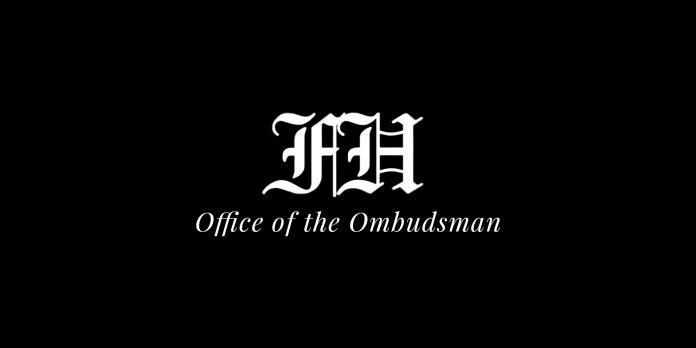Earlier this week, The New York Times Opinion section announced that it would no longer refer to guest opinion pieces as op-eds but rather call them “Guest Essays.” This is a foolhardy and dangerous move that runs contrary to ethical journalism guidelines.
Op-eds have been a part of the Times since they debuted in 1970 as a place for “stimulating new thought and provoking new discussion on public problems.” Printed opposite the Editorial page (which is where we get the term op-ed), they provide readers with voices and perspectives from outside of the paper that otherwise may not have been heard. A break from the regularly scheduled programming, if you will.
How many people know the etymology of the term well enough to know that it is short for “opposite editorial.” I’ll be honest I had to look it up to be sure. The Wikipedia page for “op-ed” starts with the proper definition and then immediately notes that the term is commonly used to mean “opinions and editorials.” This is called a backronym, an ad hoc definition given to a word/term by improper use or confusion.
Wikipedia is not where we go for in-depth research — valid point to make, reader, and I appreciate your exercising some news literacy — but it is where people go when they need a quick answer. And what does the quick answer say? That op-ed has taken on a new definition and connotation so that by now people know it as “opinions and editorials.”
It is increasingly important that people understand when they are reading an opinion versus a news article.
It is increasingly important that people understand when they are reading an opinion versus a news article. Research has shown that people are terrible at discerning news from opinion, especially online. The Flat Hat has made strides toward making it abundantly clear when a piece is an opinion. In social media posts the word “OPINION” in all caps is first, followed by the author’s name and a description. I do wonder, however, if this is still not enough. Some news websites post a bolded warning at the beginning of an article or webpage. Others place a highlighted disclaimer. Undoubtedly not all of the onus for deciphering an opinion from a news article falls on the publication. But there are certain steps that should be viewed as necessary. Opinion articles need not be idiot-proof with pop-ups or intrusive labels. But they should be first glance-proof. Draw the reader’s attention and gently remind them that what they are reading is, in fact, not a news article.
Kathleen Kingsbury, The Times’ opinion editor, announced that the name change was a result of the paper’s push for more online, digital content. There is no basis for the term op-ed anymore, she writes, “…there is no geographical “Ed” for Op-Ed to be opposite to. It is a relic of an older age and an older print newspaper design.”
This is an odd argument to make: that the Times needs to change the term op-ed because readers might get confused about what they’re reading because there are no pages to flip on the website?
“What is disappearing, though, are spaces where voices can be heard and respected, where ideas can linger a while, be given serious consideration, interrogated and then flourish or perish,” she writes later.
I’m actually not sure what she is trying to say. That the term op-ed is somehow oppressive? Or that by changing the name it opens doors that were previously closed? Has the Times been stifling opinions? The broader point is still true, if not necessary to repeat. Serious and thoughtful discourse deserves a space where it can exist and modify over time. But to say that this is a reason for changing the name away from a more clear and decisive label is a logical leap that I am not making.
“Readers immediately grasped this term during research sessions and intuitively understood what it said about the relationship between the writer and The Times,” Kingsbury writes.
Uh-oh, you said the quiet part out loud. Jack Shaffer writing for Politico claimed that “It’s not just about reader confusion. It’s about reader dollars.” While Shaffer makes some wandering points about newsletters and sales — for the record, The New York Times Company is doing just fine — his point is more valid than Kingsbury’s.
The Times’ decision hides behind these ideas of ‘journalistic integrity’ and ‘having a more transparent and clear sense of the who and what of it all’ all the while including in their argument this section dealing with focus groups that gives the impression that this was some big corporate decision.
I can see the attraction toward claiming reader clarity and transparency. The Times is likely sensitive to that issue, having had some problems in the past. However, I argue that clarity surrounding the relationship between the Times and its op-ed writers has not been and is not the problem that needs to be solved. Journalists consistently miss the mark in engaging with the public, favoring these terms while readers favor graphics and legacy. The Times – and all news outlets for that matter – needs to ensure that when a reader clicks on an article that reader knows what they’re getting. And “guest essay” tells me as a reader much less that “op-ed” or even simply “opinions” does. It is waxing poetic when it should be presented in a more appropriate and conducive manner.
One reader, in response to the decision, decided to write in with the glaringly obvious suggestion of “guest opinion.” Brilliant. That solves everyone’s problems. The Times was worried about associations with its guest writers. Well it says “guest” as the first word. And I’m concerned that people won’t understand an article is an opinion piece when it’s called an essay. What do you know? “Opinion” is the second word.

